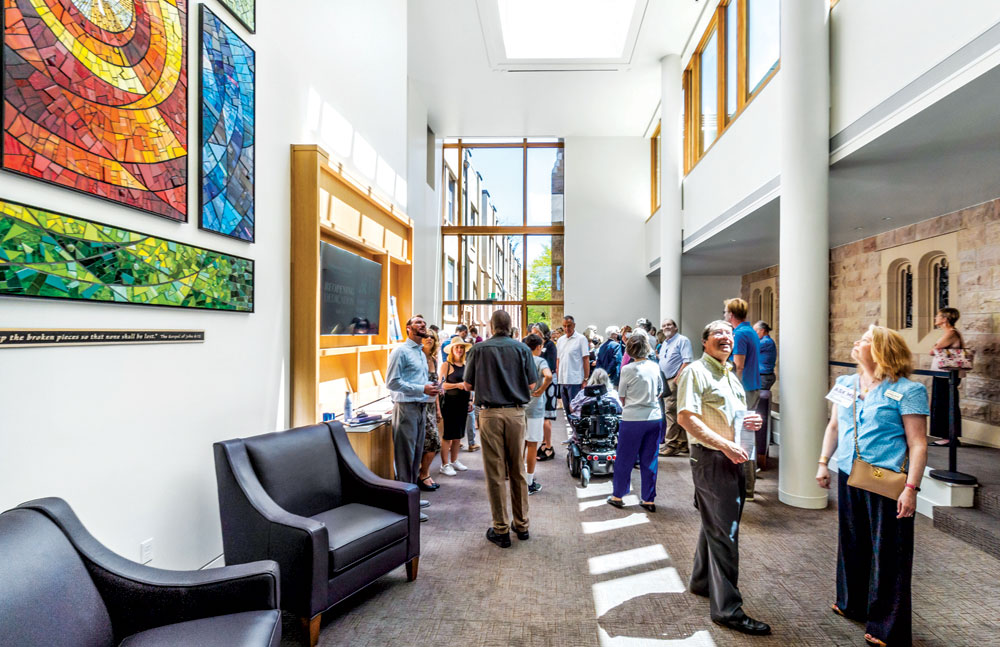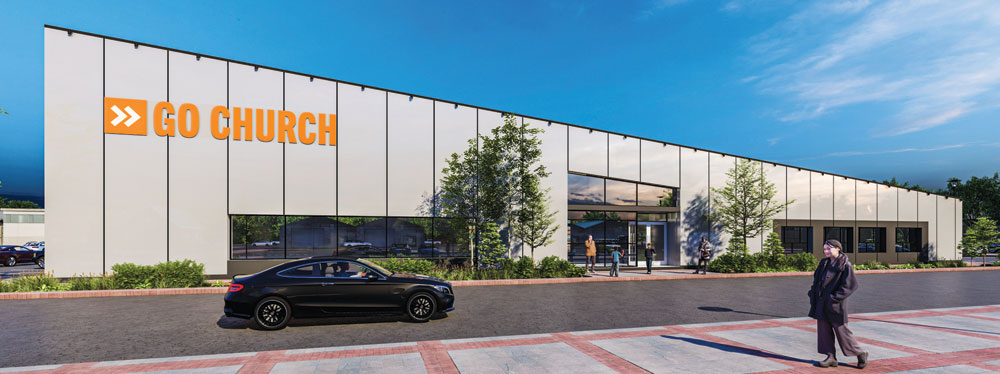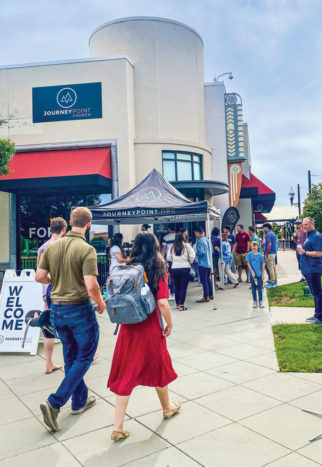
Members at Montview Boulevard Presbyterian Church get a first look at some of the renovations of their 112-year-old church, where new windows and higher ceiling make the reception area more welcoming. Photo courtesy of Montview Church
More engagement with the community is a priority for three Northeast Denver churches —and they are in the midst of some major changes to their physical spaces to reach that goal.
Montview Boulevard Presbyterian Church in Park Hill is just finishing a 2-year renovation of its 112-year-old building. The project upgraded basic infrastructure, increased accessibility, and improved meeting and performance spaces. Co-pastor Ian Cummins says the original architecture of the church was always intended for use by the wider community, but many of those spaces had fallen into neglect over the years. A centerpiece of the renovation was updating the two historic areas that had served as sanctuaries before the present-day large sanctuary was built. Those renovated spaces are more conducive for smaller weddings, neighborhood theater productions, musical recitals, art shows, and even candidate forums during election years. “It’s important that churches aren’t just for church members but that they are enmeshed in the neighborhood as a resource for the whole community,” says Cummins.
From the outside, one of the most visible changes is a modern steel-and-glass “bridge” that makes the choir loft accessible for people with mobility issues. Cummins says he hopes the modern addition helps convey the idea of the church serving as a beacon. “It’s a symbol of the light in this church going out into the world and being a positive force in the wider community.” Montview Church plans to hold a neighborhood celebration in the renovated spaces later this fall. A community theater production of “The Wizard of Oz” will take the stage in the renovated Miller Center in September.

An artist rendering of the building that Go Church plans to build at Runway 35 North. Its modern design is a nod to the aeronautical history of the neighborhood. Rendering courtesy of Go Church
GO Church, which was established in the Central Park neighborhood in 2016, had been meeting in the Willow Elementary School until the COVID-19 pandemic hit. Like many churches, it was forced to move its services onto Zoom and Facebook Live. When the pandemic began to ease, Denver school buildings were still closed for community use, so Pastor Nick Calloway had to search for a new venue. He found it at the Shops at Northfield in a space that had formerly been a jewelry store and a bike store. He says the unconventional space has both benefits and drawbacks. “I think we do get visibility and some church visitors that we wouldn’t get otherwise,” says Calloway. “But the space is too small and it’s complicated to make improvements. Our children’s program is in a separate space from where we worship, so I miss seeing the kids every Sunday.”
The 400-member, nondenominational church is about to get a major upgrade. It has purchased land at Runway 35 North, near where the In-N-Out Burger restaurant is scheduled to open. Building plans have been drawn, a developer has been hired, and a capital campaign will begin this fall. Calloway says he’s excited about the opportunity to have a bigger space to expand the congregation. “We’ve always been reflective of the neighborhood. At first it was young families, then more high school students. Now we have grandparents who have moved here to be part of their kids’ lives. As Central Park grows, we want to grow with it.”

Journey Point Church currently holds services in a former restaurant at the Shops at Northfield. Front Porch photo by Christie Gosch
Journey Point Church in Central Park has a similar story to Go Church. The 300-member, nondenominational church was started in 2019 by Pastor Chris Phillips and held worship services at Inspire Elementary School until the pandemic. In December of 2020, the church moved into a former burger joint at the Shops at Northfield where it continues to hold services and youth gatherings. “Our audio-visual area is set up in the freezer area and our youth meet across the street in a former sub shop. We call the two spaces the hub and the sub,” Phillips says with a laugh.
The church has just purchased land near the Drury Hotel in Northfield so it can build a new facility. Phillips says he and the congregation are still brainstorming about what the building should look like. “We don’t want a building that sits empty during the week, so we want to build a unique space that is fully utilized by the community.” Phillips says one idea is to build a five-story building in which the church would utilize the bottom two floors and low-income housing would occupy the upper floors. Even the bottom two floors will be designed with the neighborhood in mind. “We want to create community spaces that people can use for events and banquets, and we might offer facilities that can be used as co-working spaces on weekdays. We want to meet the needs of the community in every way that we can.”



0 Comments